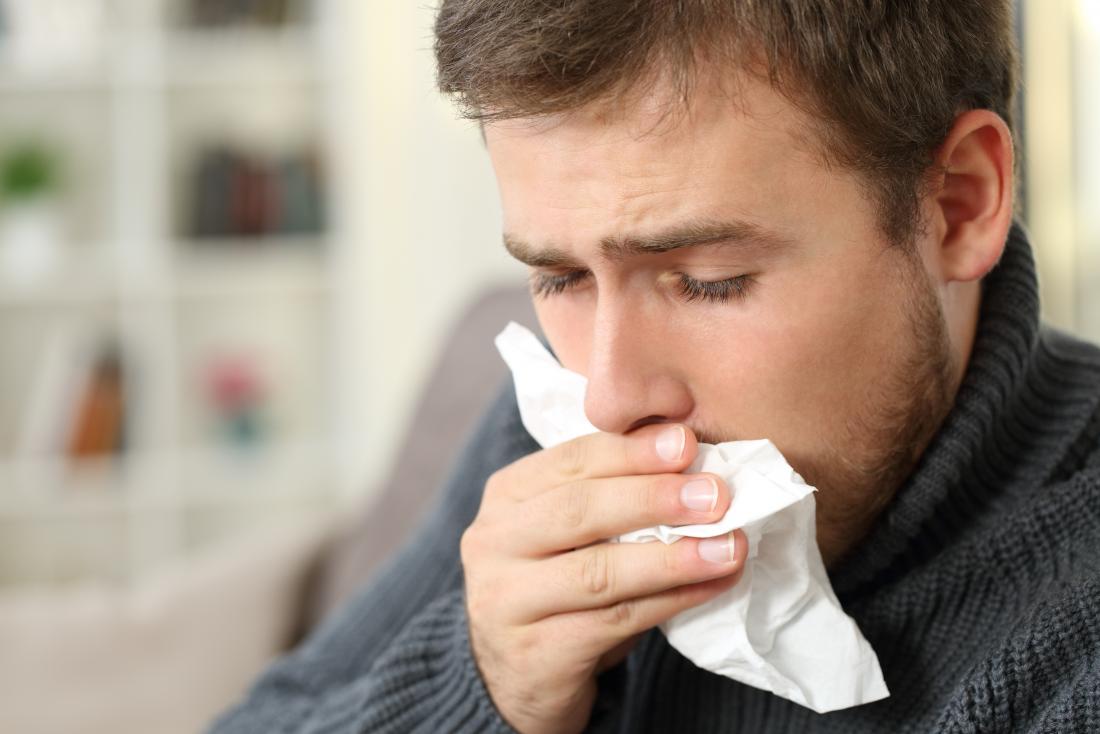Blood in sputum: Causes, diagnosis, and when to see a doctor - Medical News Today
Blood in sputum: Causes, diagnosis, and when to see a doctor - Medical News Today |
| Blood in sputum: Causes, diagnosis, and when to see a doctor - Medical News Today Posted: 24 Apr 2018 02:03 AM PDT Blood in the sputum or mucus when a person coughs or spits is called hemoptysis. Although the blood can be worrying, it is usually not a cause for concern, especially in young or otherwise healthy people. Blood in the sputum is a common event in many mild respiratory conditions, including upper respiratory infections, bronchitis, and asthma. It can be alarming to cough up a significant amount of blood in sputum or to see blood in mucus frequently. In severe cases, this can result from a lung or stomach condition. In this article, we discuss the causes and treatments of blood in sputum.
A range of factors can lead to blood in the sputum. Also, the blood may originate from different parts of the body. The blood usually comes from the lungs, but less frequently it can come from the stomach or digestive tract. If the blood comes from the digestive tract, the medical term is hematemesis.
Possible causes of blood in the sputum include:
See a doctor or seek emergency care when coughing brings up a lot of blood, or any blood at frequent intervals. If the blood is dark and appears with pieces of food, go to a hospital immediately. This can indicate a severe problem originating in the digestive tract. Also, see a doctor if any of the following symptoms accompany blood in the sputum:
To determine whether a medical condition is causing blood to appear in the sputum, a doctor will usually take a medical history and perform a physical examination. During the examination, the doctor may ask the person to cough, and they may check the nose and mouth for sites of bleeding. The doctor may also take samples of sputum and blood for testing. In some cases, additional examinations are necessary. These may include a chest X-ray, a CT scan, or a bronchoscopy, which involves a camera at the end of a tube being inserted into the airway.
Treatments aim to stop the bleeding and treat the underlying cause. Possible treatments include:
Blood in sputum, particularly in small quantities, is usually not a cause for concern. However, in people with a medical history of respiratory problems or who smoke, it often requires further evaluation. Respiratory infections, other lung conditions, and less commonly problems in the digestive tract can cause the blood to appear. Some causes are mild and resolve on their own. In other cases, medical intervention is necessary. If a coughs up blood in large amounts or at frequent intervals, they should see a doctor. |
| Weed smoker's lungs vs. smoker's lungs vs. non-smokers lungs - Medical News Today Posted: 16 Apr 2021 03:41 AM PDT  Like smoking tobacco, smoking weed or cannabis can also have damaging effects on the lungs, although research on the subject is not as clear-cut. Smoking is one of the biggest threats to lung health. The Centers for Disease Control and Prevention (CDC) report that cigarette smoking is responsible for over 480,000 deaths in the United States each year. Smoking cigarettes can have a number of negative effects on a person's lungs. These include:
Smoking cannabis can also cause damage to the lungs. This because the smoke from cannabis contains many of the same toxins, irritants, and carcinogens as tobacco smoke. In this article, we look at the effects of smoking cannabis on the lungs and compare them to the effects of smoking tobacco. There is mixed evidence on the effects of cannabis smoke on the lungs. This is because of a relative lack of literature combined with concurrent tobacco smoking and the reports of conflicting outcomes. Coughing and sputumOne study states that cannabis smoke can cause symptoms, such as increased coughing and sputum production, similar to those found in people who smoke tobacco. Another study states that the frequency of chronic cough, sputum, and wheezing was similar between cannabis smokers and tobacco smokers. The American Lung Association states that these symptoms arise due to cannabis smoke injuring the cell linings of the large airways. BronchitisSwelling and inflammation in the bronchial tubes cause bronchitis. Acute bronchitis usually clears up on its own, while chronic bronchitis is persistent and may never go away. A person with this condition usually experiences the below symptoms:
The American Lung Association says that cannabis smoke can cause a person to develop chronic bronchitis. A 2016 study also stated that smoking cannabis has links with symptoms of chronic bronchitis. Learn more about bronchitis here. Lung cancerThere is differing evidence regarding the association between cannabis smoking and lung cancer. One 2013 study stated that people who used cannabis heavily were at an increased risk of developing lung cancer. Another study from 2012 outlines that cannabis smoke contains carcinogens, which can cause cancer. However, the study adds that there is no evidence that suggests that light or moderate cannabis smoking leads to an increased risk for the development of either lung or upper airway cancer. However, the same study states that the evidence is mixed when it comes to the cancer risks of heavy or long-term cannabis use. A 2014 study suggests there is biological plausibility of cannabis smoking as a risk for the development of lung cancer. However, it adds that it is difficult to link cannabis smoking and cancer development conclusively. Learn more about cannabis and lung cancer here. Other cancersThe National Academies of Sciences, Engineering, and Medicine released their report on the health effects of cannabinoids. They found no statistical association between cannabis smoking and lung, head, and neck cancers. The report also found limited or no evidence regarding any links between smoking cannabis smoking and: There are a couple of other ways a person can consume cannabis that do not involve smoking the substance. EdiblesA person can consume cannabis in edible form, which is the name for foods and drinks infused with cannabis. Edibles deliver the cannabis to the body through the mouth and digestive system. People often see these products as an alternative to smoking or vaping. Edibles can have varying effects on individuals. Research suggests that they can be a more potent method of taking cannabis than inhaling the substance. The study showed that the effects from edibles took around 1 hour to kick in but lasted for 6 or more hours. It also showed that, in contrast, the effects of smoking or vaping tended to last 1–4 hours. Learn more about edibles here. VapingMany people inhale vaporized cannabis as an alternative to smoking it. The vaporizer heats the cannabis and extracts the cannabinoids, converting them into vapor, which a person then inhales. There are several different types of vaporizers that use alternative methods to heat cannabis. As scientists do not know the long-term safety of vaping it is not advisable for people to use this method for cannabis consumption. There are over 7,000 different chemicals in tobacco smoke, which all affect the lungs in a variety of ways. Some of these chemicals are carcinogenic, meaning they may cause cancer, while others can damage cells or trigger scarring and inflammation. Due to the abundance of chemicals, cigarette smoke can affect the lungs in many ways, including the below. Changes to the physical appearance of the lungsCigarette smoke can cause the lungs to change their appearance drastically. People commonly refer to the black pigmented material in cigarette smoke as tar. This tar can change the color of the lungs from pink to a grey or black color. Cigarette smoke can also cause the lungs to become hyperinflated and develop patches of inflammation. This may also cause the diaphragm to lose muscle, which also changes the shape of the lungs. Increases the production of mucusSmoking often causes the lungs to produce more mucus. This occurs because the smoke damages the epithelial cells that line a person's airway. This damage then triggers goblet cell production, which leads to the increased production of mucus in the lungs. This increased level of mucus in the lung has associations with chronic obstructive pulmonary disease (COPD). COPD includes two main conditions: emphysema and chronic bronchitis. These conditions can lead to:
COPD is a progressive disease, which means that the symptoms get worse over time. It is also the fourth leading cause of death in the U.S. Causes coughingThere are tiny hairs in the airways called cilia, which prevent dirt and mucus from getting into the lungs. Smoking tobacco can destroy these cilia, allowing a number of these irritants to build up in the lungs. This can then lead to the person developing a chronic cough that people sometimes refer to as "smoker's cough." This is common in long-term or daily smokers. Lowers oxygen levelsTobacco smoke contains carbon monoxide. Therefore, when a person smokes tobacco, the carbon monoxide displaces the oxygen in their blood. This deprives the organs of the oxygen they require. Organs and other parts of the body need oxygen to function properly, so it is important that a person's oxygen levels do not drop too far. The lungs also contain small blood vessels called capillaries, which allow the oxygen in the lungs to pass into the bloodstream and travel to the organs and other parts of the body. Smoking can damage the capillaries. This can lead to a person developing low oxygen levels in their blood, as less oxygen is able to pass through the damaged capillaries and into the bloodstream. A high risk of lung cancerCigarette smoking is the number one risk for lung cancer. It has links with 80–90% of lung cancer deaths in the U.S. Of the 7,000 chemicals present in cigarette smoke, many are poisonous. Around 70 of these chemicals are also carcinogens. People who smoke cigarettes are 15–30 times more likely to get lung cancer than those who do not smoke. A person who only smokes a few cigarettes each day or smokes occasionally is still increasing their risk of lung cancer. The risk increases the more cigarettes a person smokes and the longer that they continue to smoke. Smoking tobacco is very damaging to a person's lungs. However, tobacco is also a very addictive substance, and people who are addicted can experience withdrawal symptoms if they try to quit. Therefore it can be difficult for a person to quit smoking. It is worth noting that tobacco withdrawal is not usually dangerous in comparison to withdrawal from opioids or alcohol, which can be life threatening. Here are some tips that a person might find useful to help them quit smoking tobacco:
If a person is addicted to cannabis, they may experience withdrawal symptoms when trying to quit. As with tobacco, cannabis withdrawal is usually not dangerous or life threatening. When trying to quit smoking cannabis, a person should try to ease their withdrawal symptoms by following some of these tips:
Smoking has a number of damaging effects on a person's lungs. Both tobacco smoking and cannabis smoking can cause several health issues, although research on the effects of cannabis smoking on the lungs is less clear. Smoking tobacco and cannabis can lead to a person developing a cough, producing more sputum, and developing a wheeze when they breathe. They can also both lead to lung disorders such as COPD and bronchitis. Smoking tobacco can also lower a person's blood oxygen levels and is a big risk factor for developing lung cancer. However, there is mixed evidence regarding the links between cannabis smoking and lung cancer. |
| You are subscribed to email updates from "red mucus from nose,sputum" - Google News. To stop receiving these emails, you may unsubscribe now. | Email delivery powered by Google |
| Google, 1600 Amphitheatre Parkway, Mountain View, CA 94043, United States | |



Comments
Post a Comment